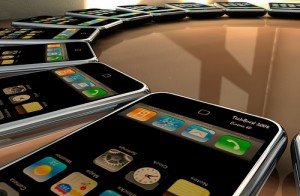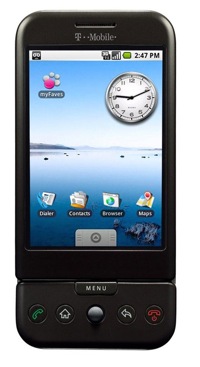 Of the major companies that announced their earnings yesterday, two of them, AT&T and Apple, beat Wall Street estimates largely thanks to a single product: The iPhone. We’re approaching the two year birthday of the device, and it still remains one of the hottest items out there. Ladies and gentleman, the state of the iPhone is strong.
Of the major companies that announced their earnings yesterday, two of them, AT&T and Apple, beat Wall Street estimates largely thanks to a single product: The iPhone. We’re approaching the two year birthday of the device, and it still remains one of the hottest items out there. Ladies and gentleman, the state of the iPhone is strong.
Yes, Apple actually sold fewer iPhones this quarter than the previous two quarters, but that was coming off of the always-hot holiday shopping quarter, and the one before that was when the iPhone 3G was still relatively new on the scene. All told, Apple has sold 21 million iPhones since its launch. Perhaps just a drop in the bucket compared to overall Nokia sales, but remember, Apple was not in the mobile business at all before 2007. And aside from just sales figures, in the past two years, it has revolutionized the industry. That is, of course, a cliche. But in this case, it’s true.
People can downplay the actual number of iPhones in circulation all they want — the fact of the matter is that it has changed things. While there were some third-party mobile app developers before Apple’s App Store, they received almost no attention, and as such, it wasn’t really a viable business. Now, everyone and their mother is flocking to develop for the App Store. And every major mobile player is rushing to make their own app stores. But Apple’s already has over 35,000 apps — and in a few short hours, there will have been one billion apps downloaded in just 9 months.
Think about that for a second: One billion apps downloaded. There are currently 37 million iPhones and iPod touches combined. Certainly, there have been a lot less than that over various stages in the last nine months, but just take that 37 million number. That means that every single one of those devices has had an average of 27 apps downloaded to it. 27 apps — that do everything from games to music to movie times to fetching me a taxi.
I remember the phone I had before the iPhone, fondly: Motorola’s RAZR. It had zero third-party apps, and the most exciting thing it could do was take a grainy picture. That was just two years ago.
Look, Apple’s iPhone platform is not perfect. The app approval process, to put it lightly, sucks. There are apps getting rejected for questionable reasons, that are forced to wait weeks to just be reviewed again. And then there are other apps which feature outrageous things, which get accepted without the slightest peep. Apple needs to revamp this system.
And the network is far from perfect as well. AT&T seems to have a failure rate that is unacceptable to a lot of people. Some have gotten rid of their iPhones just to ditch AT&T.
 But the fact of the matter is, that iPhone is simply the best all-in-one device that I’ve ever owned. I cannot imagine my life without it now. I would be lost — sometimes literally — without it. I say that because I know that of the 21 million iPhone owners out there — there are a great deal who feel the exact same way. That may be annoying, and may even sound pretentious to those who don’t own an iPhone — but I’m giving you my honest take as someone who has owned and/or tried a lot of the so-called “smartphones” out there. I have a G1. I have a Nokia N95. I’ve used a number of Blackberry devices. None compare. And I think for a lot of the other devices, it actually speaks less to the iPhone itself and more to the shit products that the other mobile companies have gotten away with putting on the market for so long.
But the fact of the matter is, that iPhone is simply the best all-in-one device that I’ve ever owned. I cannot imagine my life without it now. I would be lost — sometimes literally — without it. I say that because I know that of the 21 million iPhone owners out there — there are a great deal who feel the exact same way. That may be annoying, and may even sound pretentious to those who don’t own an iPhone — but I’m giving you my honest take as someone who has owned and/or tried a lot of the so-called “smartphones” out there. I have a G1. I have a Nokia N95. I’ve used a number of Blackberry devices. None compare. And I think for a lot of the other devices, it actually speaks less to the iPhone itself and more to the shit products that the other mobile companies have gotten away with putting on the market for so long.
And thanks in no small part to the iPhone, that could be about to change. Google’s Android platform was long seen as the next big thing, but so far, the only phone to run it, the G1, is junk. That should, hopefully change before the end of this year when new Android phones hit the market. But before then, the first real challenger should be coming — perhaps next month — with the Palm Pre. I’ve known a few people who have used the Pre a bit, and the consensus seems to be that it is the first true competitor, in terms of experience (both hardware and software), to the iPhone.
But it has some major handicaps — ones that I’ve already mentioned: 21 million, 35,000, and 1 billion. The iPhone has established itself as the standard that all mobile platforms now aspire to be. And with so much developer mindshare tied up in the platform, it will be hard for any other to come along and compete. The Pre, simply put, has to actually be better than the iPhone, if it wants to stand a chance.
For a while, it seemed like that would be the case. When the Pre was first unveiled, major hype immediately began. It had all the features the iPhone didn’t. But Apple isn’t stupid. It didn’t rush out with a buggy software update to match all the features. Instead, it sat back, worked, and then dropped the iPhone 3.0 software bomb. Not only does its update coming this summer include many of the features the Pre was touting as advantages, but it has a lot more that the Pre doesn’t offer.
And the Trojan Horse, that not a lot of people are talking about yet, is that the 3.0 software’s micro-payments system (In-App Purchases) could take the iPhone to an even higher level in terms of developer commitment. It could represent a whole new level of money for them — and Apple.
Oh yeah, and there is likely new iPhone hardware coming shortly as well.
Of course, there are still two major differentiating factors that the Pre will offer: a physical keyboard and background applications.
To me, the physical keyboard argument is a short-term one. Yes, a lot of people right now insist on having a physical keyboard — something which Apple has refused to provide. But Apple is doing that because it knows that they are not in the cards for the future of mobile devices. In the not-too-distant future, there will be screens with full haptic feedback that let you orient your hands on them. Physical keyboards will be seen for what they are: A huge waste of space.
The larger issue is background applications. Apple still refuses to run them (from third parties). You might think this is an obvious advantage for the Pre, but there are some major potential downsides. One is performance. How will the device run when multi-tasking? But the larger issue is battery life. I have a G1 that runs applications in the background. The battery life is a joke. If you think the iPhone has a poor battery, try using the G1 for a day. Or should I say, try using the G1 for about 3 hours. Good luck.
 Some developers say that if an app is made correctly, it shouldn’t drain a battery to such an extent even while running in the background. They often cite older Nokia phones and the like with applications as examples. But those older phones ran applications that are nowhere near as advanced as we have now in the post-iPhone world. If applications can be optimized for battery life, no one told the developers on the Android platform.
Some developers say that if an app is made correctly, it shouldn’t drain a battery to such an extent even while running in the background. They often cite older Nokia phones and the like with applications as examples. But those older phones ran applications that are nowhere near as advanced as we have now in the post-iPhone world. If applications can be optimized for battery life, no one told the developers on the Android platform.
And so, I have my doubts about the Pre’s main advantage, actually being an advantage at all. Again, Apple is a lot of things, but it is not stupid. If it thought allowing applications to run in the background was the best play in keeping customers happy, it would do it. Instead, it went through the painstaking process of completely redeveloping the Push Notification system to get it working. It seems to say something that now Palm has a similar service it has built into the Pre SDK, called Mojo Messaging Service.
Apple, with its still relatively small overall market share, is in a position of power right now in the US. If it had an iPhone that was $99 and could run on any major carrier, it would completely dominate this market. Instead, it’s doing things its way — just as it has always done. And that has worked for the iPod, and for iTunes, and has been working the past few years for the Mac. That also leaves a small opening for a nice Android device or the Pre to have a chance. But they can make no mistakes. Or they will be written in the Wikipedia entry for Apple next to the Zune.
[photo: flickr/techburst]